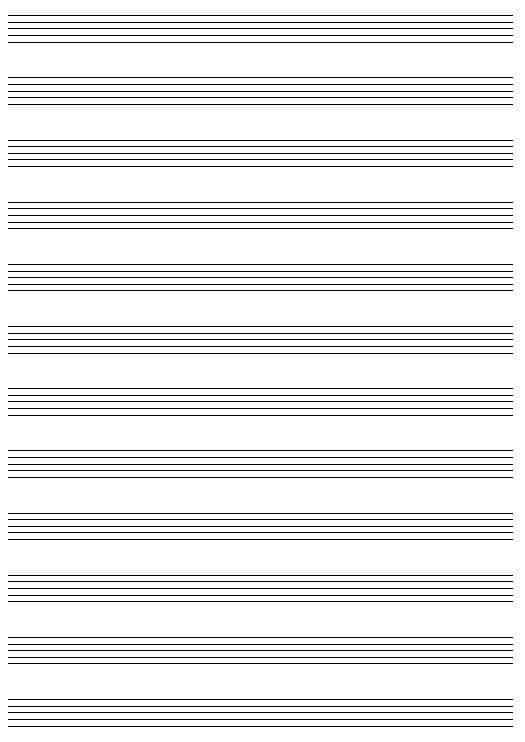MUSIC PAPER 1 GRADE 12 QUESTIONS - AMENDED SENIOR CERTIFICATE EXAMS PAST PAPERS AND MEMOS MAY/JUNE 2018
Share via Whatsapp Join our WhatsApp Group Join our Telegram GroupMUSIC
PAPER 1
GRADE 12
AMENDED SENIOR CERTIFICATE EXAMS
PAST PAPERS AND MEMOS
MAY/JUNE 2018
INSTRUCTIONS AND INFORMATION
- This question paper consists of FIVE sections, namely SECTIONS A, B, C, D and E.
- SECTIONS A and B are COMPULSORY.
- SECTION C: WESTERN ART MUSIC (WAM), SECTION D: JAZZ and SECTION E: INDIGENOUS AFRICAN MUSIC (IAM) are choice questions. Answer only ONE of these sections (SECTION C or D or E).
- Write all music notations in SECTION A in pencil and all written text in blue or black ink on this question paper.
- Answer SECTION B and SECTION C or D or E in blue or black ink in the ANSWER BOOK provided.
- Number the answers correctly according to the numbering system used in this question paper.
- The last page of this question paper is manuscript paper intended for rough work. Candidates may remove this page.
- Candidates may NOT have access to any musical instrument for the duration of this examination.
- Candidates must take note of the mark allocation for each question to provide enough information in their answers.
- Write neatly and legibly.
MARKING GRID
SECTION | QUESTION | MARKS | MARKER | MODERATOR |
A: THEORY OF MUSIC (COMPULSORY) | 1 | 20 | ||
2 | 15 | |||
3 | 10 | |||
4 | 15 | |||
SUBTOTAL | 60 |
AND
| B: GENERAL MUSIC KNOWLEDGE (COMPULSORY) | 5 | 20 | ||
| SUBTOTAL | 20 | |||
AND
| C: WAM | 6 | 10 | ||
7 | 5 | |||
8 | 5 | |||
9 | 5 | |||
10 | 15 | |||
SUBTOTAL | 40 |
OR
| D: JAZZ | 11 | 10 | ||
12 | 5 | |||
13 | 5 | |||
14 | 5 | |||
15 | 15 | |||
SUBTOTAL | 40 |
OR
| E: IAM | 16 | 10 | ||
17 | 5 | |||
18 | 5 | |||
19 | 5 | |||
20 | 15 | |||
SUBTOTAL | 40 |
| GRAND TOTAL | 120 |
QUESTIONS
SECTION A: THEORY OF MUSIC (COMPULSORY) (90 minutes)
Answer QUESTION 1
AND QUESTION 2.1 OR 2.2
AND QUESTION 3.1 OR 3.2
AND QUESTION 4.1 OR 4.2.
Answer the questions in the spaces provided on this question paper.
QUESTION 1 (25 minutes)
Study the extract from Beethoven's Violin Sonata Op. 34 and answer the questions that follow.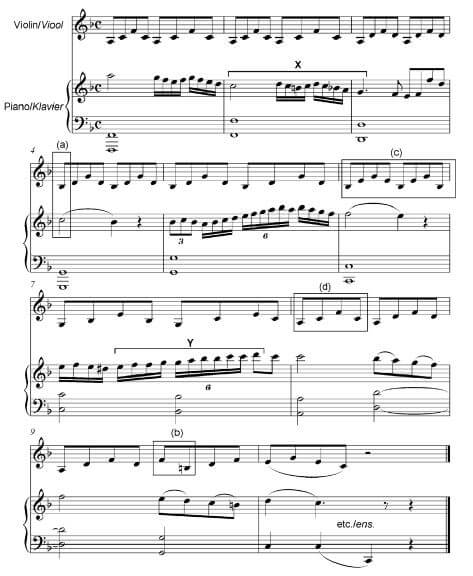
1.1 Name the main key of this piece. __________________________________ (1)
1.2 Name the intervals at (a) and (b) according to type and distance.
- __________________________________
- __________________________________ (2)
1.3 Transpose the treble clef part of the piano accompaniment of bars 2 to 31 at X a minor 3rd higher. Insert the new key signature.  (3)
(3)
1.4 Rewrite the treble clef part of the piano accompaniment of bars 2 to 31 at X an octave lower to be played by a viola. Insert the correct clef and key signature. ![]() (3)
(3)
1.5 Name the triads at (c) and (d) according to type and position. Consider only the notes in the block.
(c) __________________________________
(d) __________________________________ (2)
1.6 Add accidentals to certain ascending notes in bar 7 at Y to form a chromatic passage.  (2)
(2)
1.7 Name the key to which the music modulates in bars 8 to 10. __________________________________ (1)
1.8 Circle the enharmonic equivalent of Eb on the score. (1)
1.9 Complete the melodic fragment below by adding TWO ascending sequences in the space provided.  (2)
(2)
1.10 Name the type of scale on which the passage below is based. 
__________________________________ (1)
1.11 Complete the following whole-tone scale by adding semibreves at the asterisks (*).  (2) [20]
(2) [20]
QUESTION 2 (25 minutes)
Answer EITHER QUESTION 2.1 OR QUESTION 2.2.
2.1 Complete the opening motif below to form a twelve-bar melody in ternary form for any single-line melodic instrument of your choice. Name the instrument for which you are writing. Indicate the tempo and add dynamic and articulation indications.
Instrument: ____________________ Tempo: ________________ 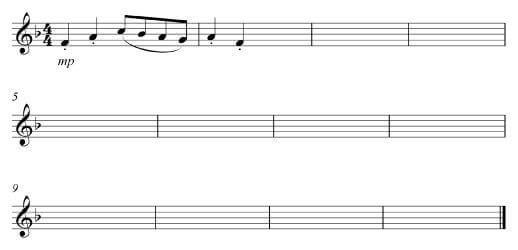
The melody will be marked according to the following criteria: [15]
DESCRIPTION | MARK ALLOCATION | CANDIDATE'S MARKS |
Form and cadential points | 3 | |
Correctness | 2 | |
Quality | 10 | |
TOTAL | 15 |
OR
2.2 Complete the opening motif below to form a twelve-bar melody in ternary form for any single-line melodic instrument of your choice. Name the instrument for which you are writing. Indicate the tempo and add dynamic and articulation indications.
Instrument: ______________________ Tempo:________________________ 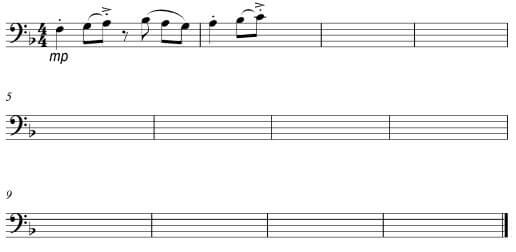
The melody will be marked according to the following criteria: [15]
DESCRIPTION | MARK ALLOCATION | CANDIDATE'S MARKS |
Form and cadential points | 3 | |
Correctness | 2 | |
Quality | 10 | |
TOTAL | 15 |
QUESTION 3 (10 minutes)
Answer EITHER QUESTION 3.1 OR QUESTION 3.2.
3.1 Study the extract from the chorale Es ist gewisslich an der Zeit by JS Bach and answer the questions that follow. 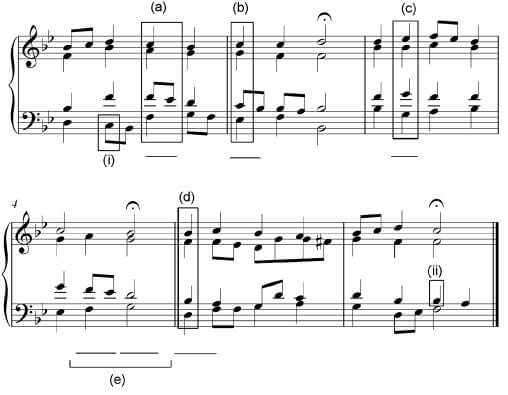
3.1.1 Name the key of this extract. ___________________________________________________ (1)
3.1.2 Identify chords (a) to (d) and figure them on the score. Use Roman numerals, e.g. IV. (4)
3.1.3 Figure and name the cadence at (e) in bar 4. Cadence____________________________________________ (2)
3.1.4 Name the type of non-chordal note at (i) and (ii).
- ___________________________________________________
- ___________________________________________________ (2)
3.1.5 With which cadence does this extract end? _____________________________________________________ (1) [10]
OR
3.2 Study the extract below from Smoke Gets In Your Eyes by Jerome Kern and answer the questions that follow.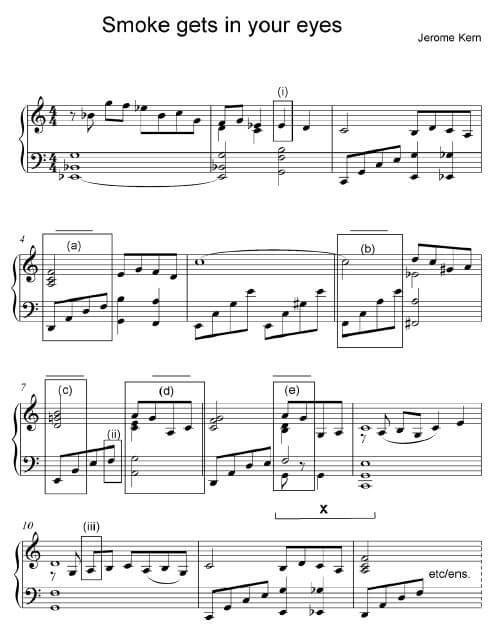
3.2.1 The main key of this work is C major. Which ONE of the keys below is the submediant minor of this key? Make a cross (X) in the appropriate block. (1)
AD minor | E minor | C minor | A minor |
3.2.2 Identify chords (a) to (e) and figure them on the score. Use chord symbols above the score, e.g. Bb/D. (5)
3.2.3 Name the type of non-chordal notes at (i), (ii) and (iii).
- _____________________________________________
- _____________________________________________
- _____________________________________________ (3)
3.2.4 Name the cadence at X in bars 8 and 9. ________________________________________________ (1) [10]
QUESTION 4 (30 minutes)
Answer EITHER QUESTION 4.1 OR QUESTION 4.2.
4.1 Complete the four-part vocal harmonisation below by adding the alto, tenor and bass parts. 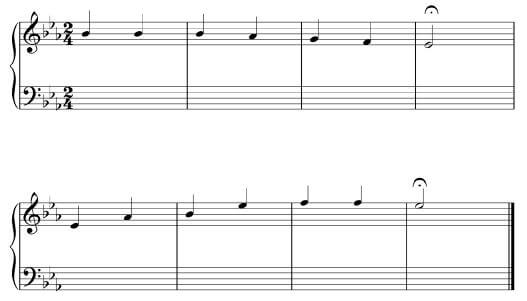
The harmonisation will be marked according to the following criteria: [15]
DESCRIPTION | MARK ALLOCATION | CANDIDATE'S MARKS |
Chord progression | 12 | |
Correctness | 14 | |
Quality | 4 | |
30 ÷ 2 | ||
TOTAL | 15 |
OR
4.2 Complete the piece below by adding a suitable bass line and harmonic material in the incomplete bars. Continue in the style suggested by the given material in bars 1 and 2. 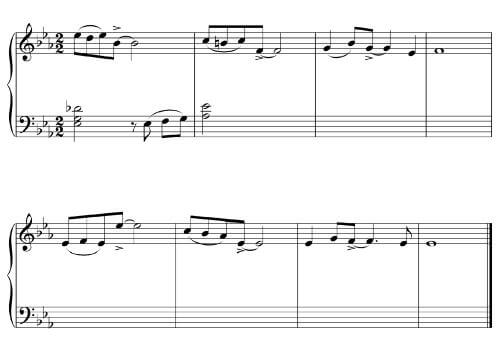
The harmonisation will be marked according to the following criteria:
DESCRIPTION | MARK ALLOCATION | CANDIDATE'S MARKS |
Chord progression Choice of chords, correct use of cadence | 14 | |
Correctness Notation, doubling, spacing, voice leading | 12 | |
Quality Musicality, non-chordal notes, awareness of style, creativity | 4 | |
30 ÷ 2 | ||
TOTAL | 15 |
[15]
TOTAL SECTION A: 60
SECTIONS B, C, D, E: GENERAL MUSIC KNOWLEDGE (90 minutes)
Answer SECTION B
AND SECTION C (Western Art Music)
OR SECTION D (Jazz)
OR SECTION E (Indigenous African Music).
Answer these questions in the ANSWER BOOK provided.
SECTION B: GENERAL (COMPULSORY)
QUESTION 5
5.1 Various options are provided as possible answers to the following questions/statements. Choose the answer and write only the letter (A to D) next to the question numbers (5.1.1 to 5.1.10) in the ANSWER BOOK, e.g. 5.1.11 D.
5.1.1 Meaning of polyphonic:
- Music with more than one melody or voice
- Two or more simultaneous lines of independent melody
- Two or more instruments playing together
- All of the above-mentioned
5.1.2 Syncopation is a term ...
- used only in pop music.
- referring to a passage with sharp accents.
- describing accents on the normally weak beats.
- All of the above-mentioned
5.1.3 An accordion is typically used in …
- boeremusiek.
- Baroque music.
- isicathamiya.
- Romantic music.
5.1.4 Tonal music …
- is based on major and minor scales.
- uses related keys in a single piece or movement.
- includes music from the Baroque and Romantic eras.
- All of the above-mentioned
5.1.5 Timbre is the …
- specific quality of a musical sound.
- type of sound a specific instrument makes, e.g. the clarinet.
- tone colour of a group of instruments, e.g. the strings.
- All of the above-mentioned
5.1.6 A very soft, dynamic level in music:
- Piano
- Mezzo piano
- Pianissimo
- All of the above-mentioned
5.1.7 ABA structure of a music work is also called …
- ternary form.
- binary form.
- verse and chorus.
- call and response.
5.1.8 Which of the following is a typical African instrument?
- Clarinet
- Mbira
- Sitar
- Koto
5.1.9 Which of the following instruments is an idiophone?
- Cowbell
- Djembe
- Banjo
- Saxophone
5.1.10 The term a cappella refers to a …
- chapel choir.
- solo.
- work without accompaniment.
- muted performance. (10 x 1) (10)
5.2 Answer the questions that follow.
5.2.1 Define the term texture with reference to music. (1)
5.2.2 Name and describe any TWO types of texture. (4)
5.3 Apart from being a performer, name FOUR other careers that you can follow in the music industry. (4)
5.4 Define the term mechanical rights. (1)
TOTAL SECTION B: 20
Answer SECTION C (WAM)
OR SECTION D (JAZZ)
OR SECTION E (IAM).
SECTION C: WESTERN ART MUSIC (WAM)
QUESTION 6
6.1 Describe THREE of the following:
6.1.1 Symphonic poem
6.1.2 Opera seria
6.1.3 Overture
6.1.4 Aria (3 x 2) (6)
6.2 Give ONE word/term for FOUR of the following descriptions:
6.2.1 The woodwind instrument that was played in the Classical orchestra but not in the Baroque orchestra
6.2.2 A non-transposing instrument in an orchestra's brass section
6.2.3 A double-reed instrument found in the standard Classical orchestra
6.2.4 A plucked sound played by the string players
6.2.5 An Italian tempo indication which means slowly (4) [10]
QUESTION 7
Write a paragraph in which you briefly comment on the comic nature of Mozart's opera, Die Zauberflöte by referring to the character of Papageno and his aria, Der Vogelfänger bin ich ja. [5]
QUESTION 8
Complete the comparison below of the first movement of Symphony No. 6 in F major, Op. 68 by Beethoven and the Overture to Die Zauberflöte by Mozart. Write only the answers next to the question numbers (8.1 to 8.5) in the ANSWER BOOK, e.g. 8.6 Ternary form. [5]
BEETHOVEN | MOZART | |
Tempo | Allegro ma non troppo | 8.1 |
Form | 8.2 | 8.3 |
Instrumentation | 8.4 | 8.5 |
QUESTION 9
Although Mendelssohn's Hebrides Overture was written during the Romantic style period, it was still heavily influenced by typical characteristics of the Classical period. Write a paragraph in which you describe these Classical influences. [5]
QUESTION 10
Beethoven's Symphony No. 6 in F major, Op. 68 has a subtitle, A recollection of country life. Refer to the statement above and write an essay in which you discuss the different expressions of country life in the FOURTH and FIFTH movements. Refer to the title and tone painting in these movements of the symphony.
You will be credited for the logical presentation of facts and the structure of your essay. The essay will be marked according to the following criteria:
CRITERIA | MARK ALLOCATION |
Fourth movement: Title | 1 |
Fifth movement: Title | 1 |
Logical presentation and structure of the essay | 3 |
TOTAL | 15 |
[15]
TOTAL SECTION C: 40
OR
SECTION D: JAZZ
QUESTION 11
11.1 Describe the following terms:
11.1.1 Swing rhythm
11.1.2 Scatting
11.1.3 Ghoema
11.1.4 Malombo (4 x 2) (8)
11.2 Give a term for the following statements:
11.2.1 An early American piano style that influenced marabi (1)
11.2.2 A short repeated phrase in jazz typically used as an introduction (1) [10]
QUESTION 12
Choose ONE of the performers and state which music characteristics you would expect to hear if you attend a concert by either Dolly Rathebe, Thandi Klaasen or Miriam Makeba. [5]
QUESTION 13
Compare the kwela, mbaqanga and marabi music styles with one another. Write only the answers next to the question numbers (13.1 to 13.5) in the ANSWER BOOK, e.g. 13.6 Brenda Fassie. [5]
KWELA | MBAQANGA | MARABI | |
Artist/band | 13.1 | 13.2 | The Manhattan Brothers |
Harmonic progression | I-IV-V-I | I-IV-V-I | 13.4 |
Instrumentation | 13.3 | Backing band and vocals | 13.5 |
QUESTION 14
Write a paragraph in which you describe the typical characteristics of the music of ONE of the artists/bands below:
- Zim Nqawana
- Spirits Rejoice
- Sakhile [5]
QUESTION 15
Write an essay on the music of ONE of the following South African jazz artists:
- Abdullah Ibrahim
- Robbie Jansen
- Winston Mankunku Ngozi
Discuss the artist's music by referring to influences, rhythm, harmony, melody, texture and instrumentation. Name at least TWO albums/songs to substantiate your answer.
You will be credited for the logical presentation of facts and the structure of your essay. The essay will be marked according to the following criteria:
CRITERIA | MARK ALLOCATION |
Music characteristics | 10 |
Albums/Songs | 2 |
Logical presentation and structure of the essay | 3 |
TOTAL | 15 |
[15]
TOTAL SECTION D: 40
OR
SECTION E: INDIGENOUS AFRICAN MUSIC (IAM)
QUESTION 16
16.1 Describe the following terms:
16.1.1 Isihlabo (2)
16.1.2 Malombo (2)
16.1.3 Kiba (2)
16.1.4 Amahubo (2)
16.2 With which instrument do you associate TWO of the following statements?
16.2.1 The smallest drum used in Kiba music
16.2.2 The chordophone that influenced the tuning style of the maskandi guitar
16.2.3 The drum used to accompany songs that call the ancestral spirits in vhaVenda culture (2) [10]
QUESTION 17
Izibongo is an integral feature of a maskandi song.
Expand on this statement by referring to the role of izibongo in maskandi. [5]
QUESTION 18
Complete the comparison below of the malombo, mbaqanga and maskandi music styles. Write only the answers next to the question numbers (18.1 to 18.5) in the ANSWER BOOK, e.g. 18.6 Miriam Makeba. [5]
MALOMBO | MBAQANGA | MASKANDI | |
Artist/band | Malombo Jazz Makers | 18.1 | Shwi Nomthekala |
Chord progression | 18.2 | I-IV-V-I | 18.3 |
Instrumentation Backing band + guitar + … | 18.4 | 18.5 | Backing band + guitar + concertina and vocals |
QUESTION 19
Describe the importance of rhythm in African music. [5]
QUESTION 20
Zulu indigenous beliefs have influenced the music and performance practices of isicathamiya.
Discuss the statement above by referring to the following:
- Relevance of animals
- Zulu family residence
- Stick fighting competitions (ukuqatha)
- Umuntu ngumuntu ngabantu
You will be credited for the logical presentation of facts and the structure of your essay. The essay will be marked according to the following criteria:
CRITERIA | MARK ALLOCATION |
The relevance of animals | 3 |
Zulu family residence | 4 |
Stick fighting competitions (ukuqatha) | 3 |
Umuntu ngumuntu ngabantu | 2 |
Logical presentation and structure of the essay | 3 |
TOTAL | 15 |
[15]
TOTAL SECTION E: 40
GRAND TOTAL: 120
